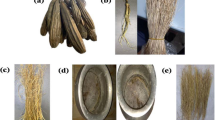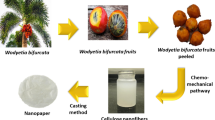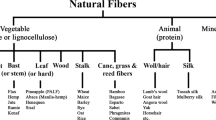Abstract
This paper discussed the effect of various blendings and numbers of beating revolutions on the dewatering properties of hybrid glass wool (HGW) suspensions and tensile strength of the associated glassfiber wet-laid mats. Different percentages of flame attenuated glass wool (FAGW) were blended with centrifuged glass wool (CGW) to form HGW samples. These HGW samples were dispersed in water by beating at various revolutions and each beaten suspension followed the papermaking steps to form subsequent hybrid glassfiber mats (HGM). The suspended solid content, drainage resistance and drainage time of each HGW suspension and pore characteristics and tensile strength of the resulting HGM were recorded. Drainage resistances of all HGW suspensions initially increased with beating revolutions up to 5000r. Afterwards, the drainage resistances fluctuated at different values. The FAGW addition aided the integrity of glass fibers during beating, tuned the microstructure and enhanced the tensile strength of HGM but sacrificed the dewatering efficiency of glass wool suspensions. According to the results from beating revolutions versus tensile strength graph, gentle beating or medium beating benefited the tensile strength of the HGM. The optimum preparation condition for glassfiber wet-laid mats with ideal microstructure, high tensile strength and low manufacturing costs was beating HGW with 30 % CGW and 70 % FAGW at 5000r.








Similar content being viewed by others
References
Lonnroth N, Muhlstein CL, Pantano C, Yue Y (2008) Nanoindentation of glass wool fibers. J Non-Cryst Solids 354:3887–3895. doi:10.1016/j.jnoncrysol.2008.04.014
Chabannes M, Nozahic V, Amziane S (2014) Design and multi-physical properties of a new insulating concrete using sunflower stem aggregates and eco-friendly binders. Mater Struct. doi:10.1617/s11527-014-0276-9
Lee S, Lee C (2013) Fire resistance of reinforced concrete bearing walls subjected to all-sided fire exposure. Mater Struct 6:943–957. doi:10.1617/s11527-012-9945-8
Shatalov AA, Pereira H (2002) Influence of stem morphology on pulp and paper properties of Arundo donax L. reed. Ind Crop Prod 15:77–83. doi:10.1016/S0926-6690(01)00098-X
Yang Q, Zhan H, Wang S, Li K, Fu S (2008) Bio-modification of eucalyptus chemithermomechanical pulp. Front Chem Eng China 2:28–33. doi:10.1007/s11705-008-0007-2
Bismarck A, Springer J (1999) Characterization of fluorinated PAN-based carbon fibers by zeta-potential measurements. Colloids Surf A 159:331–339. doi:10.1016/S0927-7757(99)00261-7
Bhardwaj NK, Kumar S, Bajpai PK (2004) Effects of processing on zeta potential and cationic demand of kraft pulps. Colloids Surf A 246:121–125. doi:10.1016/j.colsurfa.2004.08.013
Jarabo R, Fuente E, Monte MC, Savastano H Jr, Mutjé P, Negro C (2012) Use of cellulose fibers from hemp core in fiber-cement production. Effect on flocculation, retention, drainage and product properties. Ind Crop Prod 39:89–96. doi:10.1016/j.indcrop.2012.02.017
Rezk K, Nilsson L, Forsberg J, Berghel J (2013) Modelling of water removal during a paper vacuum dewatering process using a Level-Set method. Chem Eng Sci 101:543–553. doi:10.1016/j.ces.2013.07.005
Dustan AC, Cohen B, Petrie JG (2005) Modelling dewatering behaviour through an understanding of solids formation processes. Part I—Solids formation considerations. Adv Colloid Interfac 113:99–110. doi:10.1016/j.cis.2005.01.004
Rizvi MS, Kumar P, Katti DS, Pal A (2012) Mathematical model of mechanical behavior of micro nanofibrous materials designed for extracelluar matrix substitutes. Acta Biomater 8:4111–4122. doi:10.1016/j.actbio.2012.07.025
Cacciotti I, Fortunati E, Puglia D, Kenny JM, Nanni F (2014) Effect of silver nanoparticles and cellulose nanocrystals on electrospun poly(lactic) acid mats: morphology, thermal properties and mechanical behavior. Carbohyd Polym 103:22–31. doi:10.1016/j.carbpol.2013.11.052
Arifin AMT, Abdullah S, Rafiquzzaman M, Zulkifli R, Wahab DA, Arifin AK (2014) Investigation of the behaviour of a chopped strand mat/woven roving/foam-Klegecell composite lamination structure during Charpy testing. Mater Des 59:475–485. doi:10.1016/j.matdes.2014.03.005
Di X, Gao Y, Bao C, Hu Y, Xie Z (2013) Optimization of glass fiber based core materials for vacuum insulation panels with laminated aluminum foils as envelopes. Vacuum 97:55–59. doi:10.1016/j.vacuum.2013.04.005
Yang Y, Cheng X, Chen Z, Fu R, Chen Z, Qiu J, Su D (2013) Influence of density on the thermal conductivity of fiberglass felt. Adv Mater Res 628:33–36. doi:10.4028/www.scientific.net/AMR.628.33
ISO 5267.1 (2012) Pulps—determination of drainability—part 1: Schopper–Riegler method, Ethiopian Standards Agency
Li CD, Duan ZC, Chen Q, Chen ZF, Boafo FE, Wu WP, Zhou JM (2013) The effect of drying condition of glassfibre core material on the thermal conductivity of vacuum insulation panel. Mater Design 50:1030–1037. doi:10.1016/j.matdes.2013.03.021
Keshtkar M, Heuzey MC, Carreau PJ (2009) Rheological behavior of fiber-filled model suspensions: effect of fiber flexibility. J Rheol 53:631–650. doi:10.1122/1.3103546
Afra E, Yousefi H, Hadilam MM, Nishino T (2013) Comparative effect of mechanical beating and nanofibrillation of cellulose on paper properties made from bagasse and softwood pulps. Carbohydr Polym 97:725–730. doi:10.1016/j.carbpol.2013.05.032
Bhardwaj NK, Duong TD, Nguyen KL (2004) Pulp charge determination by different methods: effect of beating/refining. Colloids Surf A 236:39–44. doi:10.1016/j.colsurfa.2004.01.024
Kinoshita N, Katsuzawa H, Nakano S, Muramatsu H, Suzuki J, Ikumi Y, Toyotake Y (2000) Influence of fibre length and filler particle size on pore structure and mechanical strength of filler-containing paper. Can J Chem Eng 78:974–982. doi:10.1002/cjce.5450780515
Zeng X, Retulainen E, Heinemann S, Fu S (2012) Fibre deformations induced by different mechanical treatments and their effect on zero-span strength. Nord Pulp Pap Res J 27:335–342
Acknowledgments
This work was supported by Funding for Outstanding Doctoral Dissertation in NUAA (BCXJ13-10), Funding of Jiangsu Innovation Program for Graduate Education (the Fundamental Research Funds for the Central Universities, CXLX13_149), Major Achievements Transfer Projects of Jiangsu province (BA2013097), and a Project Funded by the Priority Academic Program Development of Jiangsu Higher Education Institutions. The first author also thanks the China Scholarship Council (CSC) for providing a scholarship for Ph.D. study at the University of California at Davis and thanks the NUAA for financial support during the short-term visit in Brunel University.
Author information
Authors and Affiliations
Corresponding author
Rights and permissions
About this article
Cite this article
Li, CD., Chen, ZF. & Saeed, MU. Characterization of hybrid glass wool suspensions and optimization of microstructure and tensile strength of the associated wet-laid mats by various blendings and numbers of beating revolutions. Mater Struct 49, 1861–1869 (2016). https://doi.org/10.1617/s11527-015-0617-3
Received:
Accepted:
Published:
Issue Date:
DOI: https://doi.org/10.1617/s11527-015-0617-3




